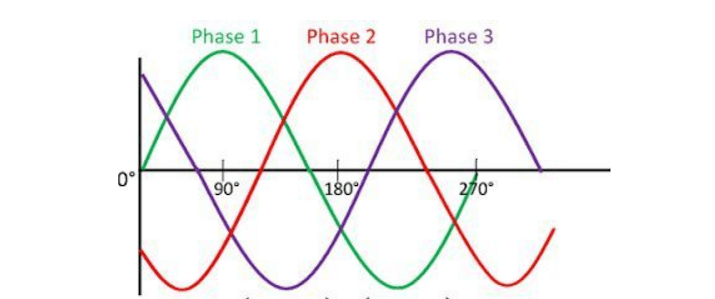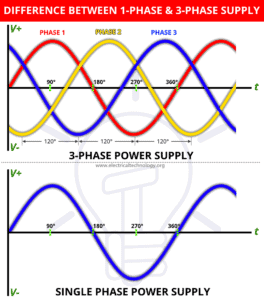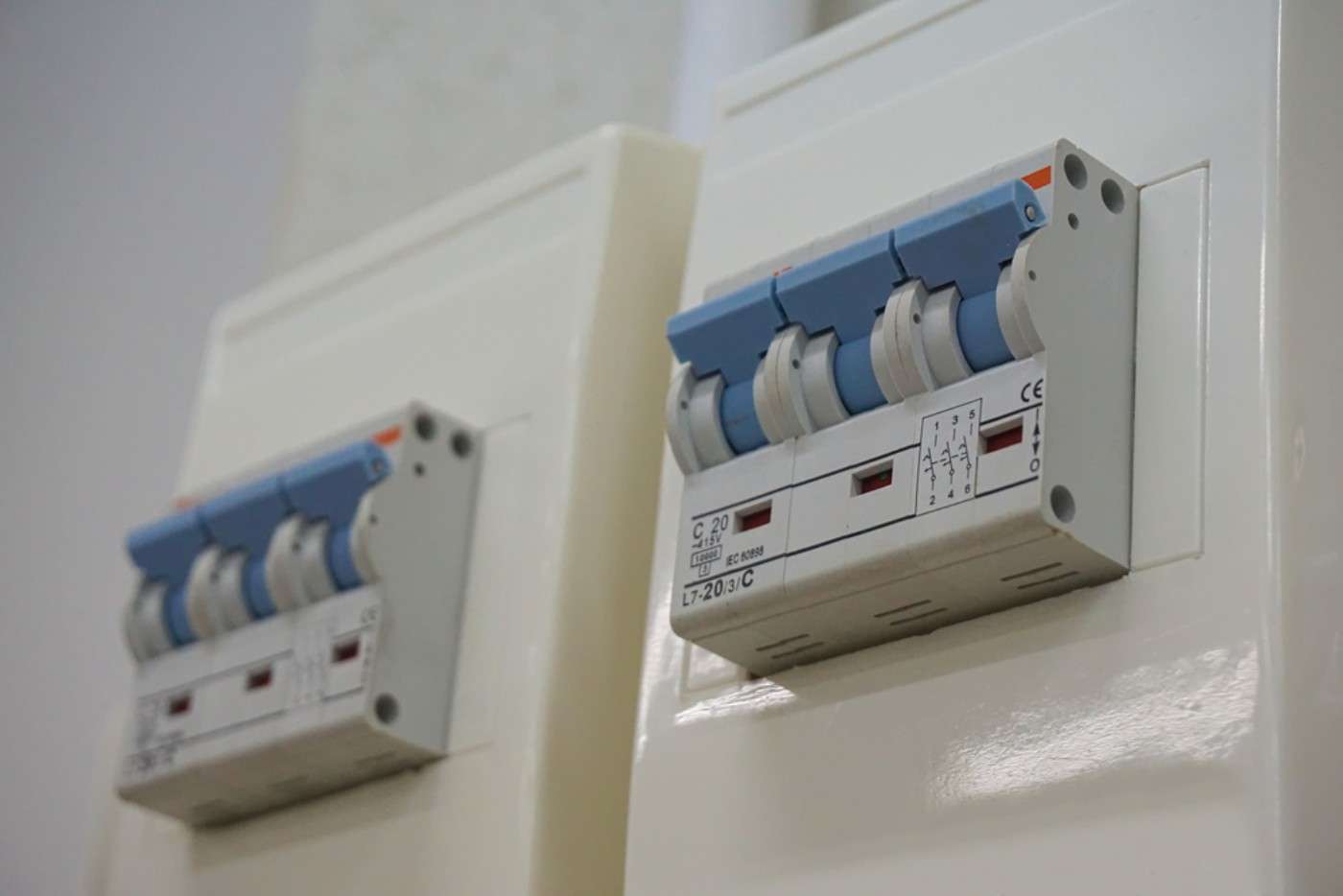
You can make two types of AC circuits: single-phase and three-phase. The single-phase circuits are easier to implement but are less efficient than three-phase circuits. On the other hand, a three-phase circuit‘s design and setup are costly. However, the operation cost will be much lower because of its power transfer efficiency. In this article, you can read about three-phase power circuits and their differences from a single-phase power circuit.

A Three-phase circuit
Contents
How does it work?
Three-phase circuit systems mean you get three different oscillating AC currents and voltages. All three oscillate from negative to positive peaks at different times. So when one voltage or current has its peak value, the other two won’t. And this means the power never goes to zero at any time during the cycle. So in a three-phase circuit, you get a constant supply of electric power.
Unlike a single-phase circuit, you need more than two wires to implement a three-phase system. And depending on the configuration, the number of load wires could be three or four. Two designs exist for a three-phase circuit: Star and Delta. In a star configuration, you need four wires, three conductor wires and one neutral wire. Delta configuration does not need a neutral wire, so it requires only three.
Advantages of a three-phase circuit
There are several advantages of a three-phase circuit:
- A three-phase system provides constant power. So you can transfer power over a distance precisely.
- For a similar output rating, the three-phase devices require less volume, saving space and cost.
- The three-phase voltage drops less from the source to the system.
- A three-phase device will be less noisy as the power is constant and not pulsating like a single-phase device.
- You can use a single-phase device in a three-phase system by only using one of the phases.
- You can start a three-phase motor automatically in a three-phase system. These don’t require starters, unlike a device working on a single-phase supply.
- The converted DC voltage of a three-phase AC has only a 4 % ripple factor. The ripple factor measures the AC component in the DC. On the contrary, DC voltage converted from a single-phase AC has a 48 % ripple factor.
Primary Differences Between Single-Phase Power and Three-Phase Power
The single-phase and three-phase power supply mainly differ in the number of separate electric currents: single-phase has one; three-phase has three. And because of this primary difference, plenty of other operational differences exist between the two.
- Single phase power supply delivers 230 volts; a three-phase power supply can provide up to 415 volts.
- You need two wires to complete the circuit of a single-phase system; a three-phase system requires a minimum of three wires.
- Single-phase systems lose more power than single-phase power supply during transmission.
- The circuit of a single-phase system requires a simple setup; because you need three or more wires, a three-phase electric circuit is complex and costly to set up.
- Unlike a single-phase power supply, having more than one phase ensures that your processes won’t entirely halt when one of the phases fails.
- The devices that consume three-phase connections are costly but more efficient. A single-phase devices are cheaper to produce even if they are less efficient. That is why household supply is single-phase.

Source: Difference Between a Three Phase and a Single-Phase Waveform
Conclusion
Traditionally, three-phase supplies were only for industries running high-powered machines. But with the advance of technology, the demand for higher power is increasing even in the cyber world. You now have more powerful computer systems in the same volume. So a rack of 10 servers consuming 5 kW ten years ago now consumes more than 20 kW. Transferring such a high power volume via a single-phase power supply would cost more. And in such a situation, a three-phase power supply would be more feasible. They are efficient enough to cover the cost of the initial setup. And the reduced ripple factor ensures less heating, increasing the lifetime of electronic equipment. So it would be better for Data Centers to switch to three-phase circuits even if it costs more to implement.
FAQs
- How
do you measure power
in a three-phase circuit?
- You measure power using a wattmeter, but you may need more than one in a complex circuit. According to Blondel Transformation’s theory, the number of wattmeters you need is one less than the number of wires in an electric circuit. So a three-phase three-wire electric circuit will need two wattmeters, and a three-phase four-wire electric circuit will need three. A wattmeter measures the power from a current and voltage input. You can use a Power Analyzer to eliminate the need for multiple wattmeters. These have more than one wattmeter in them and act as a three-phase wattmeter.
- Can
power in a three-phase circuit
be measured using less than three wattmeters?
- The Blondel Transformation relates the number of wattmeters required and the number of wires in a circuit. The number of wattmeters you require is one less than the circuit’s number of current-carrying wires. So you need a three-wire system to measure the power in a 3 phase circuit with three wattmeters. That means the 3-phase system must have a Delta configuration circuit. If it is in the Star configuration, you need four wattmeters.
- Does
3-phase power cost more than single-phase?
- A 3-phase supply transmits power more efficiently. So operational costs are significantly less than a single-phase power supply. However, the initial setup is complex because of the three wires. The implementation would cost more. In addition, the devices using 3-phase power supplies can cost more. So the three-phase power will not cost more. Many industries and offices prefer three-phase motors as they are more efficient and save more money.
- What
is the formula for power in a circuit?
- For DC circuits, the power is simply voltage times the current. Power in an AC circuit is slightly different from the voltage and currently varies as a sine wave. However, you will get an apparent ability if you multiply the voltage and current according to the specification of the AC power supply. To get the true power, you need to use mathematical integration. The ratio of actual power to apparent power is the power factor. And if you know the power factor for an AC circuit, the formula for the power becomes power = voltage x current x PF.















